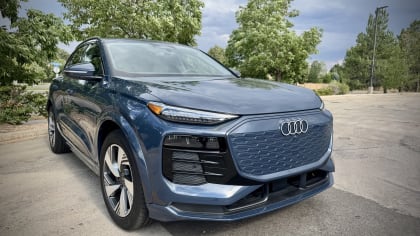VANISHING POINT REDUX
This article is from our archives and has not been updated and integrated with our "new" site yet... Even so, it's still awesome - so keep reading!
Published on Wed, May 12, 2010
By: The LACar Editorial Staff

By Brian Kennedy
Of all the ponycars, the Dodge Challenger might be the purist iteration in contemporary form. The Mustang of the current generation has departed from the pure styling cues the 2005-09 version featured in homage to the 1960s. The new Camaro is reminiscent of the first-generation version, but with angles and chunkiness that depart from that model.
But walk up to a Challenger, or see one drive by, and you’d swear you were looking at the early 1970s version of the car. The styling is an exact borrowing, and that’s a good thing, because it yields a handsome look that draws stares from way down the block. The car is not much short of menacing, so that driving it makes it easy to convince yourself that it’s 1971 again, and you’re heading downtown for a showing of Dirty Harry. And why wouldn’t you want that?
However, the perception that the car is old-school is only skin deep. Two reasons for that exist. First, like any modern muscle car, this one is far better than its predecessor. It has more power, better handling, a quieter ride, loads more equipment, and on and on.
The other reason that this car can’t be mistaken for a forty year-old version of itself is that it’s just so big. Bigger than the original, according to the tale of the tape. It’s hard to see that when you first, or just, look at the car, because the shape is so familiar. But get in one, or walk up and measure its deck height against your belly button, and you’ll realize that this thing is gigantic.

It’s an impression which transfers into the driving experience. In my week with one of these cars, an SE V6, I never gained the confidence I wanted in knowing where exactly the far side of the car was, let alone the butt. And lest you say something like, “No wonder, given that you’re used to a modern compact car,” be advised: most days, I drive a 1967 Pontiac Tempest around. That’s a seventeen-foot-long Tempest. So I know from big.
Still, if the Challenger is an oversized version of itself, is it as much fun as driving the classic that it descended from? That’s a question that’s hard to answer when you’ve driven only the six-cylinder model, as I did. Certainly, the car is competent. I took a spin up the freeway to the Madonna Inn for cake (overrated) in a blinding rainstorm, and every mile of the way I felt confident in the car and its handling. I could see this as a great choice for a long-distance commuter or a traveling salesperson. It’s big enough (by far) to feel safe, but efficient enough not to suck gas like crazy, which seems like a good tradeoff.
The 3.5-litre V6 is not what I would call powerful. The six-banger in the new Mustang, by contrast, makes that car feel quick (no, I can’t believe I just wrote that, either—I like V8s). Perhaps because of the Dodge’s size and weight-to-horsepower ratio, its V6 could maybe best be described as adequate-plus. That is, neither slow nor barely fast enough. Fast and a little bit. The kickdown on the automatic transmission when you goose the gas kind of hangs up a bit, but you’ve always got the chance to shift it yourself with the automanual function.
Had I the V8 version, my assessment of the engine feel would, obviously, be different. Gas mileage according to Dodge’s website is just slightly different (17/25 V6, 16/25 V8). I’m sure they’re giving you the straight stuff with those EPA numbers, but I got more like high-twenties in combined driving with the V6, and I’m betting you’d be lucky to get fifteen with the other car, unless you were on the highway most of the time.
But then again, the upside of the V8 would be a car that is a true muscle machine. The rumble, I imagine, would intoxicate. Then again, not everyone needs that, and especially those who would be considering the car for heavy daily use. For them, it would be more about having a car that looked great while reminding them of the vintage classic that they never had, or had and let get away.

So should you buy one? I wouldn’t do it without driving the car for a few days first, because adjusting to its size could be a problem. If you can live with the bulk, however, you have a tough choice to make: the V6 as a reasonably efficient personal cruiser, or one of the V8s as a snorting, monstrous, see-me-I’m-hardcore machine?
Tough choice, that. If you can’t afford to put gas in the V8 and still pay the mortgage, you could just keep your Honda beater for weekday driving and buy the Challenger for the evening and weekend scene.
No matter which model you end up with, however, you’ve got to get the leather interior. The seats will remind you so much of being in the 70s car, it’s sick. And since most of your time with the car will be inside, that’s a necessity if you want the full throwback experience. The leather package on the SE model is $855, including heated front seats, which of course are unnecessary in Cali, but apparently mandated with the cowhide.
The one caution here is that the function of the front seats is even more annoying than that in the newer Mustangs, if that’s possible. What neither Ford nor Dodge engineers realize, apparently, is that middle-class professionals go to work every day with a briefcase in their hands. As they enter their car, they put the front seatback forward to stow the bag in the back seat. On the Dodge, this means waiting (forever) while the electric seat moves. Then forever again to put it back. There’s no simple tip-forward function (I did read the manual, and even then, no answer). This is a pain in the tuckus so big that I would likely nix the car from my buy list for this reason. Anyone from the company reading?
But if you’re willing to put up with this (or if you never take work home—lucky you) you can also deck out the car with lots of goodies. The model I had had a really trick sunroof, nav, chrome wheels, stripes, satellite radio, and other stuff. The one exterior feature I most liked was the faux-Trans Am-racing gascap. You’ve got to get that. The other stuff is not strictly necessary, but all of it is cool. Base price for this model is $22,735. With the goodies, it’s $31,400. You could cut a couple of grand off of that if you had to by doing without the pearl coat paint ($225) and the package which includes leather-wrapped shift knob and other stuff like that. Or just find a salesperson who is actually able to fill out an order form, and get just what you want.
In terms of fit and finish and quality, the idea that the imports set a standard and the American cars fall somewhere short is just nowhere close to true these days. Everything on the Challenger is tightly screwed together. Under the hood, things are pretty, with a nice engine cover and everything in sensible places for at least minimal owner maintenance. And, to revert to the question of styling, one thing you’re going to like doing if you do buy this car is open the hood, because when you do, you’ll have the pleasure of staring at those recessed headlights and that really beautiful front-end treatment.
Panel gaps are spot-on, build quality excellent. What that adds up to is that you’ll sign the contract for your Challenger, take the title, and likely not see your dealer again until it’s time for the first oil change. By then, the magic of the car’s throwback styling will have completely taken over your life, and that’s okay, too.

Sidebar: Other useful info
This car gets five star safety ratings on everything but rollover protection (four stars). It has the usual airbags, plus supplemental side curtain front and rear airbags. That and the high sills and massive doors give you lots of assurance that you’d be okay if the worst happens.
Dodge warranties the car for five years/100,000 on the powertrain, and three years/36,000 on the “basic limited” warranty.
This car is 70 percent made up of Canadian and US parts, 16 percent Mexican. The engine and tranny come from the US, and the final assembly point in Brampton, Ontario.

For more information on Dodge products, go to dodge.com SPECIFICATIONS Name of vehicle: 2010 Dodge Challenger SE Price: $22,735 EPA rated fuel economy (city/highway miles per gallon): 17/25 Engine: 3.5 liter SOHC V6 Horsepower: 250 at 6400 rpm Torque: 250 pound-feet at 2500 rpm Transmission: Five-speed automatic with auto-stick manual-matic sequential mode Drive configuration: Rear-wheel drive Steering: Power-assisted rack and pinion Suspension Front: Independent, SLA with coil spring over shocks, stabilizer bar, lateral and diagonal lower links Rear: Independent, five-link with coil springs, link-type stabilizer bar, shocks, link-type stabilizer bar, and isolated suspension cradle Brakes: Power-assisted disc brakes with anti-lock brake system (ABS) and electronic stability control (ESC) Dimensions Length: 197.7 inches Width: 75.7 inches Height: 57.1 Curb weight: 3720 pounds




